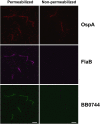BB0744 Affects Tissue Tropism and Spatial Distribution of Borrelia burgdorferi
- PMID: 26150534
- PMCID: PMC4534636
- DOI: 10.1128/IAI.00828-15
BB0744 Affects Tissue Tropism and Spatial Distribution of Borrelia burgdorferi
Abstract
Borrelia burgdorferi, the etiologic agent of Lyme disease, produces a variety of proteins that promote survival and colonization in both the Ixodes species vector and various mammalian hosts. We initially identified BB0744 (also known as p83/100) by screening for B. burgdorferi strain B31 proteins that bind to α1β1 integrin and hypothesized that, given the presence of a signal peptide, BB0744 may be a surface-exposed protein. In contrast to this expectation, localization studies suggested that BB0744 resides in the periplasm. Despite its subsurface location, we were interested in testing whether BB0744 is required for borrelial pathogenesis. To this end, a bb0744 deletion was isolated in a B. burgdorferi strain B31 infectious background, complemented, and queried for the role of BB0744 following experimental infection. A combination of bioluminescent imaging, cultivation of infected tissues, and quantitative PCR (qPCR) demonstrated that Δbb0744 mutant B. burgdorferi bacteria were attenuated in the ability to colonize heart tissue, as well as skin locations distal to the site of infection. Furthermore, qPCR indicated a significantly reduced spirochetal load in distal skin and joint tissue infected with Δbb0744 mutant B. burgdorferi. Complementation with bb0744 restored infectivity, indicating that the defect seen in Δbb0744 mutant B. burgdorferi was due to the loss of BB0744. Taken together, these results suggest that BB0744 is necessary for tissue tropism, particularly in heart tissue, alters the ability of B. burgdorferi to disseminate efficiently, or both. Additional studies are warranted to address the mechanism employed by BB0744 that alters the pathogenic potential of B. burgdorferi.
Copyright © 2015, American Society for Microbiology. All Rights Reserved.
Figures





Similar articles
-
Inactivation of the fibronectin-binding adhesin gene bbk32 significantly attenuates the infectivity potential of Borrelia burgdorferi.Mol Microbiol. 2006 Mar;59(5):1591-601. doi: 10.1111/j.1365-2958.2005.05042.x. Mol Microbiol. 2006. PMID: 16468997
-
Bioluminescent imaging of Borrelia burgdorferi in vivo demonstrates that the fibronectin-binding protein BBK32 is required for optimal infectivity.Mol Microbiol. 2011 Oct;82(1):99-113. doi: 10.1111/j.1365-2958.2011.07801.x. Epub 2011 Aug 30. Mol Microbiol. 2011. PMID: 21854463 Free PMC article.
-
Borrelia burgdorferi lacking DbpBA exhibits an early survival defect during experimental infection.Infect Immun. 2008 Dec;76(12):5694-705. doi: 10.1128/IAI.00690-08. Epub 2008 Sep 22. Infect Immun. 2008. PMID: 18809667 Free PMC article.
-
Adhesion mechanisms of Borrelia burgdorferi.Adv Exp Med Biol. 2011;715:35-49. doi: 10.1007/978-94-007-0940-9_3. Adv Exp Med Biol. 2011. PMID: 21557056 Free PMC article. Review.
-
That's my story, and I'm sticking to it--an update on B. burgdorferi adhesins.Front Cell Infect Microbiol. 2014 Apr 3;4:41. doi: 10.3389/fcimb.2014.00041. eCollection 2014. Front Cell Infect Microbiol. 2014. PMID: 24772392 Free PMC article. Review.
Cited by
-
Getting under the birds' skin: tissue tropism of Borrelia burgdorferi s.l. in naturally and experimentally infected avian hosts.Microb Ecol. 2020 Apr;79(3):756-769. doi: 10.1007/s00248-019-01442-3. Epub 2019 Oct 15. Microb Ecol. 2020. PMID: 31612324
-
Phosphoenolpyruvate Phosphotransferase System Components Modulate Gene Transcription and Virulence of Borrelia burgdorferi.Infect Immun. 2015 Dec 28;84(3):754-64. doi: 10.1128/IAI.00917-15. Infect Immun. 2015. PMID: 26712207 Free PMC article.
-
Structural determination of the complement inhibitory domain of Borrelia burgdorferi BBK32 provides insight into classical pathway complement evasion by Lyme disease spirochetes.PLoS Pathog. 2019 Mar 21;15(3):e1007659. doi: 10.1371/journal.ppat.1007659. eCollection 2019 Mar. PLoS Pathog. 2019. PMID: 30897158 Free PMC article.
-
Genetic Manipulation of Borrelia.Curr Issues Mol Biol. 2021;42:307-332. doi: 10.21775/cimb.042.307. Epub 2020 Dec 10. Curr Issues Mol Biol. 2021. PMID: 33300496 Free PMC article. Review.
-
A Dual Luciferase Reporter System for B. burgdorferi Measures Transcriptional Activity during Tick-Pathogen Interactions.Front Cell Infect Microbiol. 2017 May 31;7:225. doi: 10.3389/fcimb.2017.00225. eCollection 2017. Front Cell Infect Microbiol. 2017. PMID: 28620587 Free PMC article.
References
Publication types
MeSH terms
Substances
Grants and funding
LinkOut - more resources
Full Text Sources
Medical

